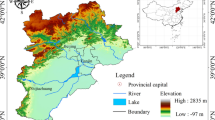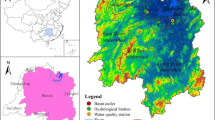Abstract
Although the water area is one of the six types of biologically productive land in the ecological footprint model, it is only described on its biological production not including its aquatic production function. An improved ecological footprint model was proposed to assess regional aquatic sensitivity. The water area account in the traditional ecological footprint model was expanded and modified to include the four accounting items: aquatic pollution footprint, aquatic pollutants’ carrying capacity, aquatic ecological profit and loss and aquatic ecological pressure index. Totally the procedure introduced in the sensitivity assessment includes the five steps: (1) collecting information and calculating the amount of sewage discharged into the surface water of the region; (2) calculating the ecological footprint of different pollutants by the improved ecological footprint model, and identifying the maximum value of the footprints as the final pollution footprint; (3) evaluating the ecological carrying capacity of the region; (4) assessing the degree of aquatic pollution using the indicators of ecological deficit and ecological surplus; (5) determining the aquatic environmental sensitivity level using the aquatic pollution pressure value. The assessment model was applied to analyze the town-level aquatic environmental sensitivity in the coastal areas of Jiangsu province, China. The assessment showed that the aquatic pollution footprints in the 367 towns were in the downward trend and the aquatic pollution sensitivity decreased from 2014 to 2018. The model might improve the description of the functions on providing natural resources and consuming waste in natural systems in the footprint model. The evaluation model could objectively assess the pressure status of the regional aquatic pollution sensitivity and provide some effective suggestions for decision makers on the utilization and protection of regional water resources.





Similar content being viewed by others
References
Amundrud SL, Srivastava DS (2015) Drought sensitivity predicts habitat size sensitivity in an aquatic ecosystem. Ecology 96:1957–1965
Bao C, Fang CL (2012) Water resources flows related to urbanization in China: Challenges and perspectives for water management and urban development. Water Resour Manage 26:531–552
Cao XC, Wu PT, Wang YB, Zhao XN (2014) Water footprint of grain product in irrigated farmland of China. Water Resour Manage 28:2213–2227
Chen BL, Qian WR, Yang YD, Liu H, Wang LL (2021) Carbon footprint and water footprint of cashmere fabrics. Fibres Text East Eur 29:94–99
Cheng X, Chen LD, Sun RH, Jing YC (2019) Identification of regional water resource stress based on water quantity and quality: a case study in a rapid urbanization region of China. J Clean Prod 209:216–223
Cui LL, Li GS, Ouyang NL, Mu FY, Yan F, Zhang YT, Huang XY (2018) Analyzing coastal wetland degradation and its key restoration technologies in the coastal area of Jiangsu, China. Wetlands 38:525–537
Destek MA, Okumus I (2019) Does pollution haven hypothesis hold in newly industrialized countries? Evidence from ecological footprint. Environ Sci Pollut Res 26:23689–23695
Dong QJ, Zhang X, Chen YL, Fang DB (2019) Dynamic management of a water resources-socioeconomic-environmental system based on feedbacks using system dynamics. Water Resour Manage 33:2093–2108
Feng CL, Wu FC, Mu YS, Meng W, Dyer SD, Fan M, Raimondo S, Barron MG (2013) Interspecies correlation estimation-applications in water quality criteria and ecological risk assessment. Environ Sci Technol 47:11382–11383
Ferretti V, Montibeller G (2019) An integrated framework for environmental multi-impact spatial risk analysis. Risk Anal 39:257–273
Guo Z, Ge SS, Yao XL, Li H, Li XY (2020) Life cycle sustainability assessment of pumped hydro energy storage. Int J Energy Res 44:192–204
Handayani W, Kristijanto AI, Hunga AIR (2019) A water footprint case study in Jarum village, Klaten, Indonesia: The production of natural-colored batik. Environ Dev Sustain 21:1919–1932
Jin X, Li X, Feng Z, Wu J, Wu K (2020) Linking ecological efficiency and the economic agglomeration of China based on the ecological footprint and nighttime light data. Ecol Indic 111
Li RH, Guo P, Li JB (2018) Regional water use structure optimization under multiple uncertainties based on water resources vulnerability analysis. Water Resour Manage 32:1827–1847
McDonald GW, Patterson MG (2004) Ecological footprints and interdependencies of New Zealand regions. Ecol Econ 50
Mekonnen MM, Pahlow M, Aldaya MM, Zarate E, Hoekstra AY (2015) Sustainability, efficiency and equitability of water consumption and pollution in Latin America and the Caribbean. Sustainability 7:2086–2112
Mu YS, Wu FC, Chen C, Liu YD, Zhao XL, Liao HQ, Giesy JP (2014) Predicting criteria continuous concentrations of 34 metals or metalloids by use of quantitative ion character-activity relationships-species sensitivity distributions (QICAR-SSD) model. Environ Pollut 188:50–55
Rees W (1996) Urban ecological footprints: Why cities cannot be sustainable—And why they are a key to sustainability. Environ Impact Assess Rev 16
Shu R, Cao XC, Wu MY (2021) Clarifying regional water scarcity in agriculture based on the theory of blue, green and grey water footprints. Water Resour Manage 35:1101–1118
Su Y, Gao WJ, Guan DJ, Su WC (2018) Dynamic assessment and forecast of urban water ecological footprint based on exponential smoothing analysis. J Clean Prod 195:354–364
Sultana J, Tibby J, Recknagel F, Maxwell S, Goonan P (2020) Comparison of two commonly used methods for identifying water quality thresholds in freshwater ecosystems using field and synthetic data. Sci Total Environ 724
Sun FF, Sheng D, Ma MM, Liu L (2019) Evaluation on implementation of water law in China. Water Resour Manage 33:2599–2613
Tang DH, Liu XJ, Zou XQ (2018) An improved method for integrated ecosystem health assessments based on the structure and function of coastal ecosystems: a case study of the Jiangsu coastal area, China. Ecol Ind 84:82–95
Vuuren DPV, Smeets EMW (2000) Ecological footprints of Benin, Bhutan, Costa Rica and the Netherlands. Ecol Econ 34
Wackernagel M, Onisto L, Bello P, Linares AC, Falfán ISL, Garcı́a JM, Guerrero AIS, Guerrero MGS (1999) National natural capital accounting with the ecological footprint concept. Ecol Econ 29
Wang B, Yu G, Huang J, Hu HY (2008) Development of species sensitivity distributions and estimation of HC5 of organochlorine pesticides with five statistical approaches. Ecotoxicology 17:716–724
Wang X, Fan SL, Xiao J, Li Y, Zhang XL, Wang ZL (2020) Distribution of zooplankton in the Jiangsu coastal area: Relationship with the drift path of green algae. Mar Pollut Bull 151
Wohler L, Niebaum G, Krol M, Hoekstra AY (2020) The grey water footprint of human and veterinary pharmaceuticals. Water Res X:7
Wu FC, Mu YS, Chang H, Zhao XL, Giesy JP, Wu KB (2013a) Predicting water quality criteria for protecting aquatic life from physicochemical properties of metals or metalloids. Environ Sci Technol 47:446–453
Wu GY, Li LH, Ahmad S, Chen X, Pan XL (2013b) A dynamic model for vulnerability assessment of regional water resources in arid areas: a case study of Bayingolin, China. Water Resour Manage 27:3085–3101
Wu MY, Wei YG, Lam PR, Liu FZ, Li Y (2019) Is urban development ecologically sustainable? Ecological footprint analysis and prediction based on a modified artificial neural network model: a case study of Tianjin in China. J Clean Prod 237
Xu Z, Hong Y, Zhifeng Y, Bin C, Yan Q (2010) Applying the input-output method to account for water footprint and virtual water trade in the Haihe River basin in China. Environ Sci Technol 44
Yang Y, Ling S, Zhang T, Yao CX (2018) Three-dimensional ecological footprint assessment for ecologically sensitive areas: a case study of the Southern Qin Ling piedmont in Shaanxi, China. J Clean Prod 194:540–553
Yao H, Liu H, Ni T (2019) Estimation of the value of aquatic ecosystem services in the coastal area of Jiangsu Province, China. Integr Environ Assess Manag 15:1012–1020
Yao H, Qian X, Yin H, Gao HL, Wang YL (2015) Regional risk assessment for point source pollution based on a water quality model of the Taipu River, China. Risk Anal 35:265–277
Zhang Y, Wu XY, Wang LL, Ding XM (2014) The industrial water footprint of zippers. Water Sci Technol 70:1025–1031
Acknowledgements
This work was sponsored by the National Natural Science Foundation of China (41501601) and the Natural Science and Technology Project of Nantong (MS12018035). No conflict of interest exits in the submission of this manuscript, and the manuscript is approved by all authors for publication.
Author information
Authors and Affiliations
Contributions
Hong Yao conceived and designed the study; Huan Liu, Qingxiang Zhang and Guangyuan Niu performed the assessment; Huan Liu wrote the paper; Huan Liu, Yuxi Yang and Hong Yao critically reviewed the manuscript and added helpful explanations. All authors read and approved the final version of the manuscript.
Corresponding author
Ethics declarations
Ethics Approval
All authors kept to the Ethical Responsibilities of Authors.
Consent to Participate
Not applicable.
Consent to Publish
The authors declare that they consent to publish this manuscript.
Competing of Interest
The authors declare that they have no conflict of interest.
Additional information
Publisher's Note
Springer Nature remains neutral with regard to jurisdictional claims in published maps and institutional affiliations.
Rights and permissions
About this article
Cite this article
Liu, H., Niu, G., Zhang, Q. et al. Town-Level Aquatic Environmental Sensitivity Assessment Based on an Improved Ecological Footprint Model. Water Resour Manage 36, 763–777 (2022). https://doi.org/10.1007/s11269-021-03058-0
Received:
Accepted:
Published:
Issue Date:
DOI: https://doi.org/10.1007/s11269-021-03058-0




